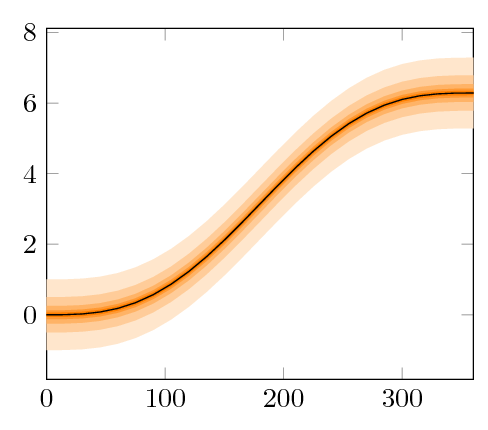Here, the trick is to use stack plots=y together with closedcycle to create the error bands.
We define a new command, \addplotwitherrorbands[<optional styles>]{<function>}{<positive error>} {<negative error>} for this spurpose.
Edit and compile if you like:\documentclass[border=5pt]{standalone}
\usepackage{pgfplots}
\pgfplotsset{width=7cm,compat=1.8}
\tikzset{
error band/.style={fill=orange},
error band style/.style={
error band/.append style=#1
}
}
\newcommand{\addplotwitherrorband}[4][]{
\addplot [#1, draw=none, stack plots=y, forget plot] {#2-(#3)};
\addplot +[#1, draw=none, stack plots=y, error band] {(#3)+(#4)}\closedcycle;
\addplot [#1, draw=none, stack plots=y, forget plot] {-(#2)-(#3)};
\addplot [#1, forget plot] {#2};
}
\begin{document}
\begin{tikzpicture}[
declare function={f(\x)=rad(\x)-sin(\x);}
]
\begin{axis}[domain = 0:360, enlarge x limits = false,
cycle list = {
error band style = orange!20\\
error band style = orange!40\\
error band style = orange!60\\
error band style = orange!80\\
error band style = orange!100\\
}
]
\pgfplotsinvokeforeach{1,0.5,0.25,0.125, 0.0625} {
\addplotwitherrorband [] {f(x)}{#1}{#1}
}
\end{axis}
\end{tikzpicture}
\end{document}
